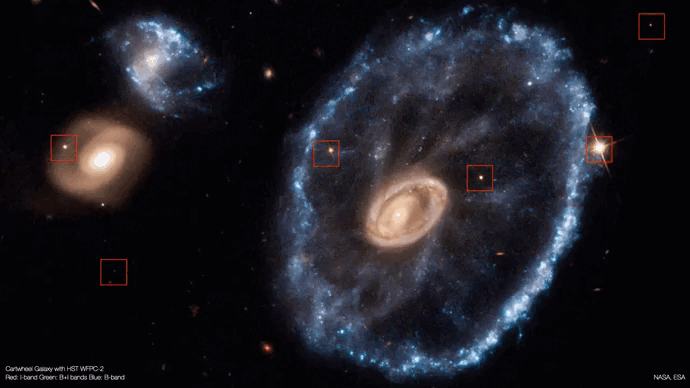Several years separate two images taken by the Hubble and James Webb telescopes. They show us how certain stars, which we see in front of the Chariot Wheel, have moved in 27 years.
It is still a beautiful view of the Universe that the James Webb telescope has made it possible to obtain. On August 2, 2022, NASA unveiled the awe-inspiring image of the Cartwheel galaxy taken by JWST. This galaxy had already been observed in the past thanks to the Hubble space telescope, in 1995. Thanks to James Webb, we can now go beyond some of the limits of Hubble, to see new details in the images.
In a shared tweet on August 5, 2022, Mark McCaughrean, a member of the ESA (European Space Agency), shows a comparison between the image of the Cartwheel taken by the Hubble telescope and that taken by the James Webb telescope. Here we can observe in an impressive way the movements and displacements of the stars located in the foreground of the image, in a lapse of time of 27 years.
Stars dancing in front of the galaxy for 27 years
The movements made by the stars, as depicted in this animation, are similar to dance steps. But, what exactly is going on? Why have the stars moved so much in almost 3 decades? According to Mark McCaughreanthe motions of the stars could be due to the rotation of our galaxy, the Milky Way, in which these four stars are located “. In other words, we would be perceiving the rotation of our galaxy, via the displacements of stars on the images.
We also know that the stars have a “proper motion”: over the years, they advance relative to each other, seen from the Earth, thus also causing the constellations to change. Edmund Halley is the first astronomer and physicist to wonder about this. He had been able to observe the movement of three stars, considered among the brightest: Procyon, Arcturus and Sirius. The astronomer came to the conclusion that these were indeed moving in the galaxy. Nevertheless, here, Mark McCaughrean does not seem to evoke this track of explanation.
On the image published by ESA, we can also notice the presence of several luminous rings. The first ring, located a little more in the center, has a very high luminosity, while the second, which is located more outside, would have been expanding for 440 million years.
